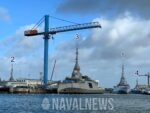In a high-profile demonstration of strategic reach and deterrence signaling, a U.S. Air Force B-52H Stratofortress conducted a long-range flight near Venezuelan airspace in early October 2025. The mission—executed under the auspices of U.S. Southern Command (SOUTHCOM)—marks a rare deployment of nuclear-capable heavy bombers to the Caribbean theater and reflects evolving regional posture amid geopolitical tensions.
Mission Overview and Strategic Context
According to official U.S. Air Force releases and open-source tracking data corroborated by defense analysts, the B-52H sortie originated from Barksdale Air Force Base (Louisiana), home to the 2nd Bomb Wing under Air Force Global Strike Command (AFGSC). The bomber flew southward over the Gulf of Mexico before skirting international airspace near Venezuela’s northern coast on October 3rd, 2025.
The flight was part of a Bomber Task Force (BTF) mission aimed at demonstrating “U.S. commitment to regional security and freedom of navigation,” according to SOUTHCOM statements. While remaining outside Venezuelan sovereign airspace, the aircraft’s proximity—within radar range—was clearly intended as a calibrated signal to both Caracas and regional observers.
This operation comes amid increased Russian military cooperation with Venezuela and Nicaragua, including reports of joint naval exercises and arms deliveries earlier in 2025. The presence of Russian Tu-160 bombers in Venezuela as recently as late 2024 has raised concerns in Washington about Moscow’s expanding influence in Latin America—a region traditionally considered within the U.S. strategic periphery.
B-52H Stratofortress Capabilities Remain Central to US Deterrence
The Boeing B-52H remains one of the cornerstones of America’s nuclear triad despite its Cold War origins. With eight turbofan engines and an unrefueled range exceeding 14,000 km (8,700 miles), the aircraft can carry up to approximately 31,500 kg (70,000 lbs) of mixed payload—including conventional JDAMs or AGM-series cruise missiles as well as nuclear gravity bombs or ALCMs (Air-Launched Cruise Missiles).
Although this particular mission was reportedly non-nuclear armed—as per peacetime norms—the platform’s dual-capable nature is central to its signaling value. Its radar cross-section is large by modern standards but irrelevant for missions where visibility is intentional.
- Crew: Five (pilot, co-pilot, radar navigator/bombardier, electronic warfare officer)
- Range: ~14,000 km unrefueled; extended with aerial refueling
- Payload: Up to ~31.5 tonnes; mix of conventional/nuclear munitions
- Service life: Expected through at least mid-2050s with ongoing modernization
The B-52 fleet is undergoing significant upgrades under the Commercial Engine Replacement Program (CERP), integrating Rolls-Royce F130 engines for improved fuel efficiency and reliability. Avionics modernization includes new AESA radar systems derived from F/A-18 technology and enhanced C2 interfaces for network-centric operations.
SOUTHCOM’s Evolving Posture Amid Regional Instability
The use of strategic bombers within SOUTHCOM’s area of responsibility is relatively rare compared to theaters like INDOPACOM or EUCOM but has increased modestly since late 2023 due to growing concerns over Chinese and Russian activities in Latin America.
SOUTHCOM Commander Gen. Laura Richardson has repeatedly emphasized the need for persistent presence operations—both naval and aerial—to deter malign influence campaigns by extra-regional powers exploiting weak governance structures across Central America and parts of South America.
The October BTF flight aligns with these objectives by showcasing global reach without permanent basing—a key tenet of Agile Combat Employment (ACE) doctrine now being adopted across major USAF commands.
Venezuelan Reaction and Regional Implications
The Maduro government condemned the flight as “provocative” and accused Washington of violating international norms—a claim not supported by available flight tracking data showing adherence to international airspace boundaries.
This response mirrors previous rhetoric following similar flights or naval deployments near Venezuelan waters but may reflect deeper unease over potential shifts in U.S.-Colombian defense cooperation or regional missile defense initiatives involving NATO-standard systems such as NASAMS or Iron Dome variants deployed experimentally in Colombia since mid-2024.
Regional allies such as Brazil and Colombia have remained publicly neutral on this specific mission but continue bilateral security dialogues with Washington focused on counter-narcotics interdiction technologies—including ISR drones like MQ-9 Reapers—and maritime domain awareness platforms such as P-8A Poseidons operating out of cooperative security locations.
BTF Missions Reflect Broader Global Deterrence Strategy
This sortie forms part of a broader pattern under AFGSC’s Bomber Task Force initiative whereby bombers are routinely deployed forward—often unpredictably—to dissuade adversaries from miscalculating American resolve or capability gaps caused by force dispersion or budgetary constraints.
- BTF Europe: Regular B-1B/B-52 deployments to RAF Fairford supporting NATO deterrence missions
- BTF INDOPACOM: Guam-based rotations supporting Pacific deterrence vs China/North Korea
- BTF Arctic/High North: Recent missions over Norway/Iceland highlighting polar route access
- BTF SOUTHCOM: Emerging theater; likely future focus given hemispheric instability trends
The flexibility afforded by these missions allows combatant commanders to tailor messaging while preserving strategic ambiguity—a hallmark feature especially important when dealing with actors like Iran or North Korea who monitor bomber movements closely via OSINT channels.









